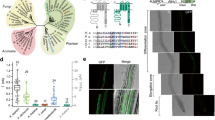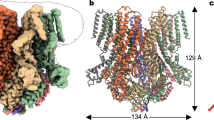Abstract
Vacuoles, the storage organelles of plants, can constitute up to 90% of the cell volume. Transport of solutes such as sugars and organic and inorganic ions across the vacuolar membrane constitutes one of the major cellular achievements during diurnal and annual cycles of carbon metabolism. Recent investigations by patch-clamp techniques1 identified ion channels and pumps as pathways for the movement of ions and metabolites2–4. The mechanisms by which these transport proteins are regulated remain unknown. Changes in the cytoplasmic concentration of Ca2+ have been postulated to be involved in the physiology of various ion transport processes in plant cells5–9. But in contrast to animal cells10, to date no direct evidence exists for the modulation of ion-transport proteins by Ca2+ in plant cells. Here we report that in plant vacuoles, changes in cytoplasmic Ca2+ regulate the activation of two distinct types of voltage-dependent ion channels. A 60–80 pS channel appeared at Ca2+ levels above 10−7 M, activating slowly (SV—slow vacuolar type) upon application of hyperpolarizing voltage pulses. The voltage-threshold of appearance changed with the cytoplasmic Ca2+ concentration. At low Ca2+ a smaller channel (30–40 pS) activated instantaneously (FV—fast vacuolar type) upon application of both depolarizing and hyperpolarizing voltages. The two channel types modulated by physiological changes of cytoplasmic Ca2+ provide for versatile regulation of ion and metabolite fluxes between the cytoplasm and the vacuole.
This is a preview of subscription content, access via your institution
Access options
Subscribe to this journal
Receive 51 print issues and online access
We are sorry, but there is no personal subscription option available for your country.
Buy this article
- Purchase on SpringerLink
- Instant access to full article PDF
Prices may be subject to local taxes which are calculated during checkout
Similar content being viewed by others
References
Hamill, O. P., Marty, A., Neher, E., Sakmann, B. & Sigworth, F. J. Pflügers Arch. ges. Physiol. 391, 85–100 (1981).
Hedrich, R., Flügge, U. I. & Fernandez, J. M. FEBS Lett. 3910, 228–232 (1986).
Coyaud, L., Kurkdjian, A., Kado, R. & Hedrich, R. Biochim. biophys. Acta. (in the press).
Kolb, H-A., Köhler, K. & Martinoia, E. J. Membrane Biol. 95, 163–169 (1987).
Hepler, P. K. & Wayne, R. O. A. Rev. Pl. Physiol. 36, 397–439 (1985).
Marme, D. & Dieter, P. in Calcium and Cell Function Vol. IV (ed. Cheung, W. Y.) 263–311 (Academic, New York, 1983).
Jones, R. L., Deikman, J. & Melroy, M. J. in Molecular and Cellular Aspects of Calcium in Plant Development (ed. Trewavas, A. J.) 175–183 (Plenum, New York, 1986).
Lunevsky, V. Z., Zherelova, O. M., Vostrikov, I. Y. & Berestovsky J. Membrane Biol. 72, 43–58 (1983).
Mimura, T. & Tazawa, M. Protoplasma 118, 49–55 (1983).
Hille, B. Ionic Channels of Excitable Membranes (Sinauer, Sunderland, Massachusetts, 1984).
Marty, A. Trends Neurosci. 6, 262–265 (1983).
Miller, A. J. & Sanders, D. Nature 326, 397–400 (1987).
Williamson, R. E. & Ashley, C. C. Nature 296, 647–651 (1982).
Brownless, C. &. Wood, J. W. Nature 320, 624–626 (1986).
Bennett, A. B. & Spanswiek, R. M. Pl. Physiol. 74, 545–548 (1984).
Gardeström, P. FEBS Lett. 4412, 114–118 (1987).
Martinoia, E., Flügge, U. I., Kaiser, G., Heber, U. & Heldt, H. W. Biochim. biophys. Acta 806, 311–319 (1985).
Gilroy, S., Hughes, W. A. & Trewavas, A. J. FEBS Lett. 4436, 133–137 (1987).
Rincon, M. & Boss, W. F. Pl. Physiol. 83, 395–398 (1987).
Schumaker, K. S. & Sze, H. J. biol. Chem. 262, 3944–3946 (1987).
Morse, M. J., Crain, R. C. & Satter, R. L. Pl. Physiol 80, 486 (1986).
DeSilva, D. L. R., Hetherington, A. M., & Mansfield, T. A. New Phytol. 100, 473–483 (1985).
DeSilva, D. L. R., Cox, R. C., Hetherington, A. M. & Mansfield, T. A. New Phytol. 101, 555–563 (1985).
Schwartz, A. Pl. Physiol. 79, 1003–1005 (1985).
Schnabl, H., Elbert, C. & Krämer, G. J. exp. Bot. 33, 996–1003 (1983).
Gerhardt, R. & Heldt, H. W. Pl. Physiol. 75, 542–547 (1984).
Lüttge, U. New Phytol. 105, 593–629 (1987).
Martell, A. E. & Smith, R. M. Critical Stability Constants (Plenum, London, 1974).
Author information
Authors and Affiliations
Rights and permissions
About this article
Cite this article
Hedrich, R., Neher, E. Cytoplasmic calcium regulates voltage-dependent ion channels in plant vacuoles . Nature 329, 833–836 (1987). https://doi.org/10.1038/329833a0
Received:
Accepted:
Issue Date:
DOI: https://doi.org/10.1038/329833a0
This article is cited by
-
Electrophysiology and fluorescence to investigate cation channels and transporters in isolated plant vacuoles
Stress Biology (2022)
-
A calcium signalling network activates vacuolar K+ remobilization to enable plant adaptation to low-K environments
Nature Plants (2020)
-
Voltage-dependent gating of SV channel TPC1 confers vacuole excitability
Nature Communications (2019)
-
Role of auxin (IAA) in the regulation of slow vacuolar (SV) channels and the volume of red beet taproot vacuoles
BMC Plant Biology (2018)
-
Naringenin Impairs Two-Pore Channel 2 Activity And Inhibits VEGF-Induced Angiogenesis
Scientific Reports (2017)



